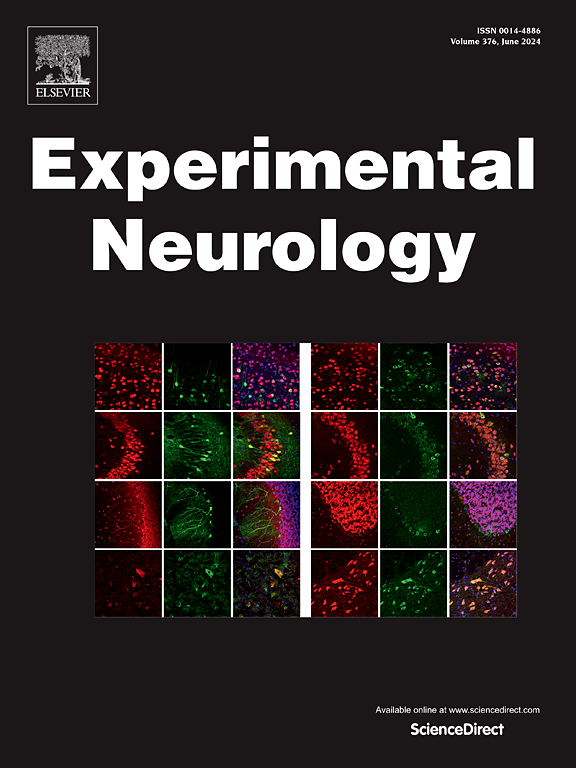Neuroprotective agents ineffective in mitigating autonomic dysreflexia following experimental spinal cord injury
IF 4.6
2区 医学
Q1 NEUROSCIENCES
引用次数: 0
Abstract
Background and objectives
Loss of supraspinal cardiovascular control and secondary damage following spinal cord injury (SCI) lead to cardiovascular dysfunction, where autonomic dysreflexia (AD), triggered by stimuli below the injury, can cause uncontrolled blood pressure (BP) surges, posing severe health risks such as stroke and seizures. While anti-inflammatory neuroprotective agents have been studied for motor recovery, their impact on cardiovascular function remains under investigated. The objective was to assess the efficacy of four clinically approved neuroprotective agents in promoting cardiovascular recovery following SCI.
Methods
Male Wistar rats received contusion at the third thoracic spinal segment (T3). Fluoxetine, Glyburide, Valproic acid, and Indomethacin were first administered at 1 h or 6 h post-SCI, and every 12 h for two weeks thereafter. Four weeks following SCI, hemodynamics were measured at rest and during colorectal distension. Locomotor function was assessed prior to SCI and weekly for four weeks after SCI, using the Basso-Beattie-Bresnahan (BBB) locomotor scale. Quantitative comparisons of lesion area were performed.
Results
Contrary to the published literature, Indomethacin and Valproic acid resulted in high morbidity and mortality rates 60 % and 40 % respectively) within 2–3 days of administration. Fluoxetine, and Glyburide were well-tolerated. There were no differences in change in systolic BP with colorectal distension compared to control i.e., all experimental groups experienced severe episodes of AD [F(6, 67) = 0.94, p = 0.47]. There was no significant difference in BBB scores in any experimental group compared to control [F(18, 252) = 0.3, p = 0.99]. No between-group differences were observed in tissue sparing at the lesion epicentre [F(6, 422) = 6.98, p = 0.29].
Discussion
Despite promising beneficial effect reported in previous studies, none of the drugs demonstrated improvement in cardiovascular or motor function. Indomethacin and Valproic acid exhibited unexpected high mortality at doses deemed safe in the literature. This emphasizes the necessity for reproducibility studies in pre-clinical research and underscores the importance of publishing null findings to guide future investigations.
神经保护剂无法有效缓解实验性脊髓损伤后的自主神经反射障碍。
背景和目的:脊髓损伤(SCI)后脊髓上心血管控制的丧失和继发性损伤会导致心血管功能障碍,损伤下方的刺激会引发自主神经反射障碍(AD),导致血压(BP)飙升失控,带来严重的健康风险,如中风和癫痫发作。虽然抗炎神经保护剂已被用于研究运动恢复,但其对心血管功能的影响仍未得到充分研究。本研究旨在评估四种临床认可的神经保护剂在促进 SCI 后心血管恢复方面的功效:雄性 Wistar 大鼠第三胸椎节段(T3)受到挫伤。在脊髓损伤后 1 小时或 6 小时首次给药氟西汀、格列本脲、丙戊酸和吲哚美辛,之后每 12 小时给药一次,持续两周。脊髓损伤后四周,测量静息时和结肠扩张时的血液动力学。使用巴索-巴蒂-布雷斯纳汉(Basso-Beattie-Bresnahan,BBB)运动功能量表,在脊髓损伤前和脊髓损伤后四周内每周对运动功能进行评估。对病变区域进行了定量比较:与已发表的文献相反,吲哚美辛和丙戊酸在用药后 2-3 天内的发病率和死亡率较高,分别为 60% 和 40%。氟西汀和格列本脲的耐受性良好。与对照组相比,结肠直肠胀气时收缩压的变化没有差异,即所有实验组都出现了严重的急性肠梗阻发作[F(6, 67) = 0.94, p = 0.47]。与对照组相比,所有实验组的 BBB 评分均无明显差异 [F(18, 252) = 0.3, p = 0.99]。在病灶中心组织疏松方面,没有观察到组间差异[F(6,422)= 6.98,P = 0.29]:讨论:尽管之前的研究显示了良好的疗效,但没有一种药物能改善心血管或运动功能。在文献认为安全的剂量下,吲哚美辛和丙戊酸表现出意想不到的高死亡率。这强调了在临床前研究中进行可重复性研究的必要性,并突出了公布无效研究结果以指导未来研究的重要性。
本文章由计算机程序翻译,如有差异,请以英文原文为准。
求助全文
约1分钟内获得全文
求助全文
来源期刊

Experimental Neurology
医学-神经科学
CiteScore
10.10
自引率
3.80%
发文量
258
审稿时长
42 days
期刊介绍:
Experimental Neurology, a Journal of Neuroscience Research, publishes original research in neuroscience with a particular emphasis on novel findings in neural development, regeneration, plasticity and transplantation. The journal has focused on research concerning basic mechanisms underlying neurological disorders.
 求助内容:
求助内容: 应助结果提醒方式:
应助结果提醒方式:


